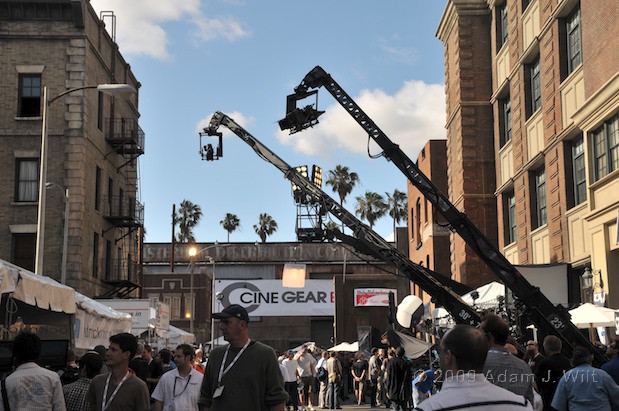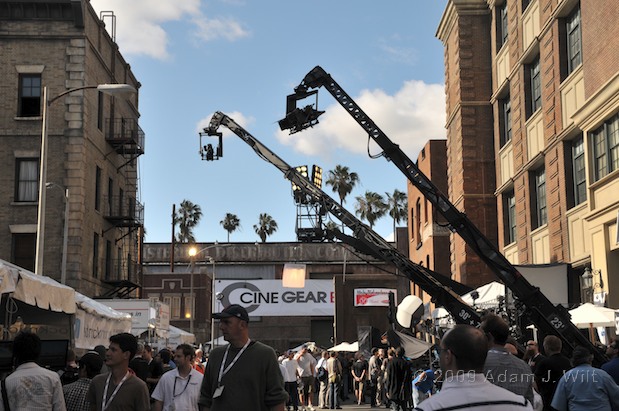
The “expo” part of Cine Gear Expo took place on Friday and Saturday last week (there were also Master Classes and film screening starting Thursday and ending Sunday). This year it was at “the Studios at Paramount” in Hollywood at Gower and Melrose. It was a balmy 70ºF (21º C) under cinematically cloudy skies, a far cry from the 100+º F of last year.
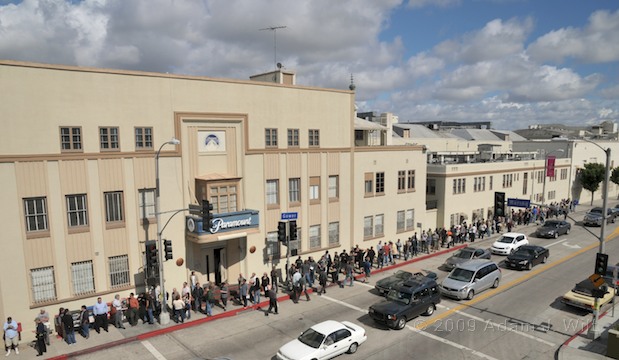
Friday afternoon crowds awaiting admission.
This year, the badge-issuing process was uncharacteristically speedy. However, the doors didn’t open until a full hour after the announced opening time, so nobody felt deprived of a pointless wait in queue!
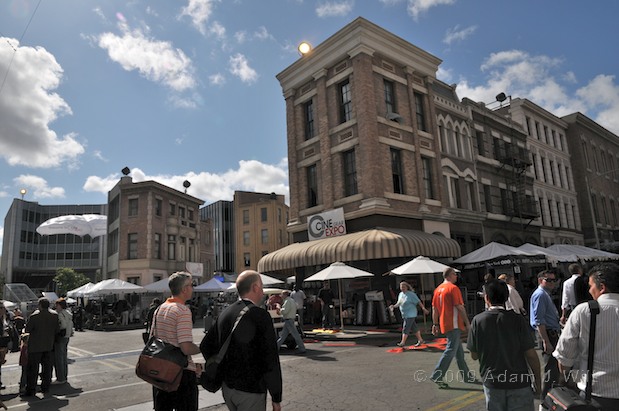
Main street, downtown, Anytown USA
You want architecture, we got architecture… with a strategic mix of varied but generic styles, Paramount can give you the look and feel of many different locations all within the span of a few “city” blocks.
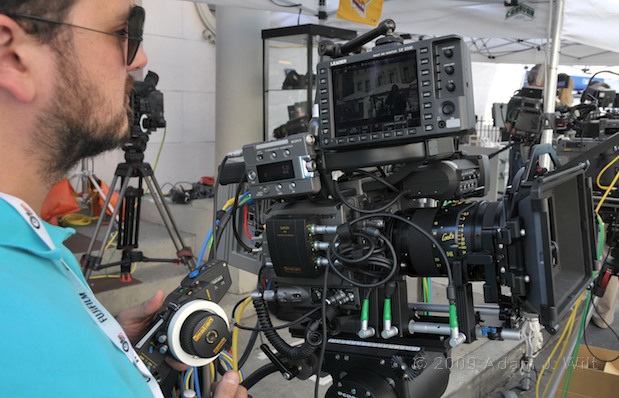
BandPro‘s Randy Wedick shows off some toys.
Randy Wedick demoed some handy camera accessories.
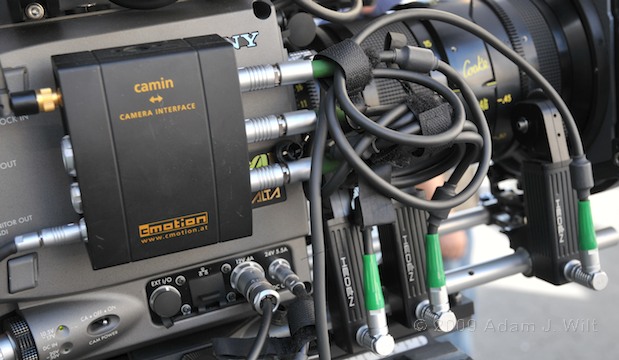
A 3-channel cmotion lens control system on a Sony F35.
cmotion makes remote lens and camera controls; they’re a European alternative to the Preston FIZ (Focus, Iris, Zoom) controllers. Here, the controller is using industry-standard Heden motors to drive the lens (it’ll work with most other motors as well).
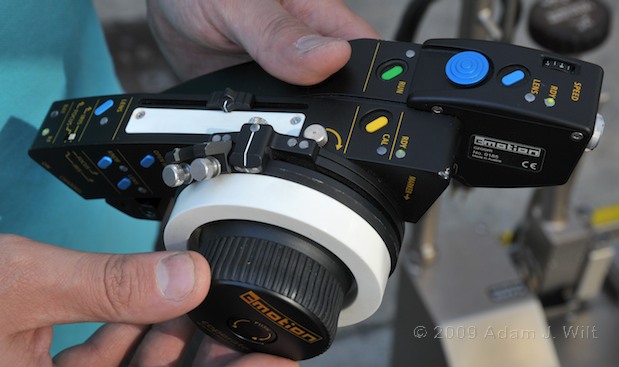
The cmotion handset.
The knob controls focus, the slider handles iris, and the blue hat switch runs the zoom. The focus knob has mechanical endstops you can use to limit your focus to a preset range.
A three-channel system, with motors, is around US$30K. There’s also a remote video monitor for the system that shows lens settings alongside the actual picture.
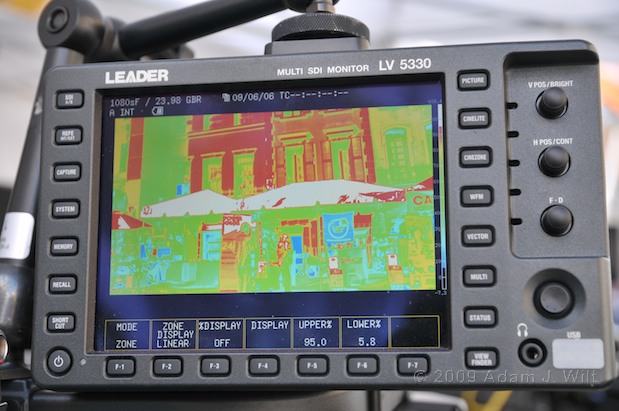
Leader LV 5330 in “cinezone” false-color mode.
The new LV 5330 is only “around $7K or $8K” despite having false-color, WFM, parade, vectorscope, audio level, and pixel-for-pixel modes on its 1024×768 LCD. Why so cheap, relatively speaking? It’s single-link only; no 3G dual-link capability.
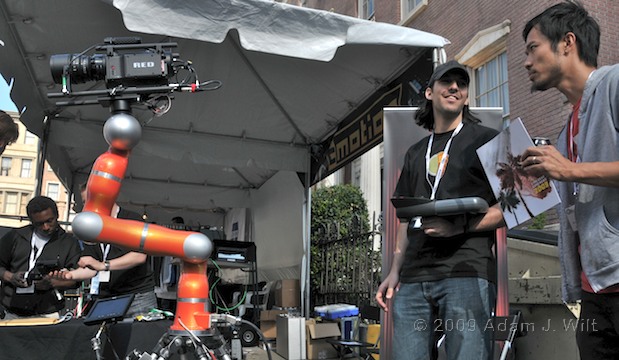
CMOCOS camera robot.
The CMOCOS camera motion control system seen at the REDuser NAB party showed up at Cine Gear. It offers full programmability as well as a “handheld” mode: it lets you grab the camera and move it around by hand, and it can then replay that move. Price? Not really sure yet. Shipping? Some time in 2010.
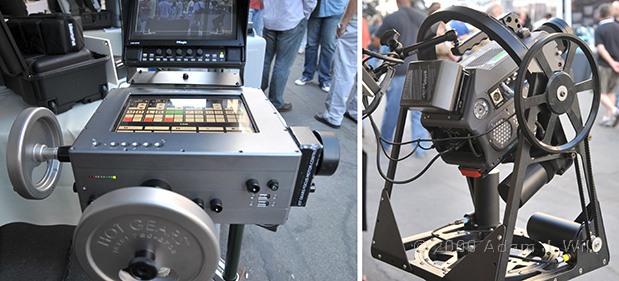
Hot Gears 3-axis controller and remote head.
Hot Gears offers multi-axis remote heads with full motion recording and playback capabilities. A system like this, I’m told, rents for about $850/day.
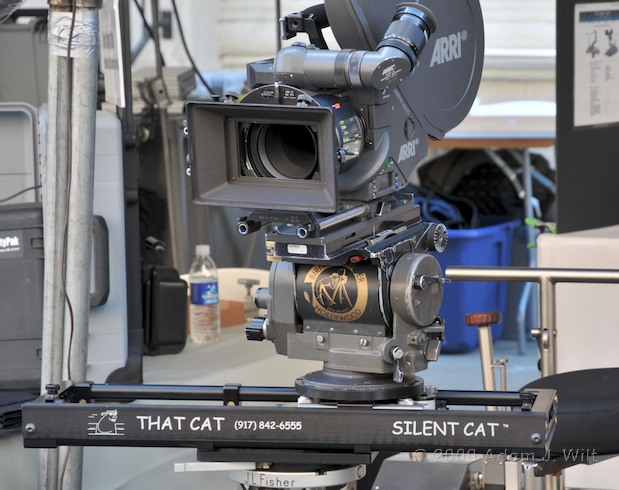
The Silent Cat.
That Cat‘s Silent Cat is a camera slider, one of many that were on offer. Along with 3D stereo rigs, sliders seem to be the hot ticket these days. If you only need a couple of feet of camera motion, why hassle with track when you can use a slider?
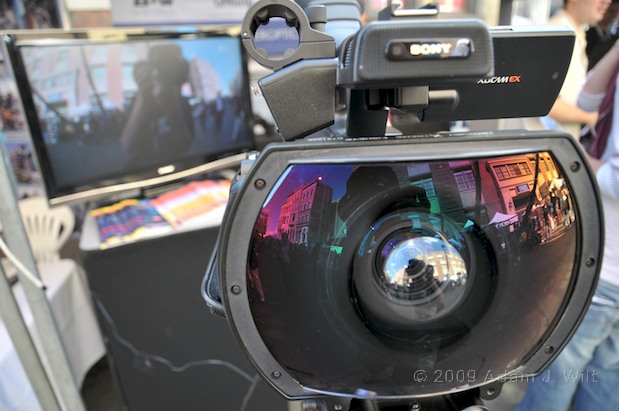
Century Optics Xtreme fisheye adapter for the PMW-EX1 and EX3
It converts the EX1/EX3’s 5.8-81.2mm zoom to a 1.7-6.6mm zoom. Sweet! $3500! Also heavy:
Schneider is not liable for any damage caused to the camera, lens, or lens mount when using the Xtreme Fisheye without the 15mm rail support system.
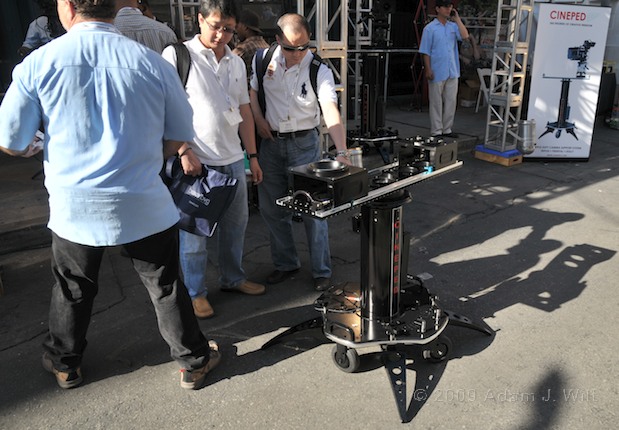
Cineped: three tools in one?
Cineped claims to be a tripod, dolly, and pedestal all in one. I’m presuming the “dolly” aspect is handled by the integral slider mechanism.
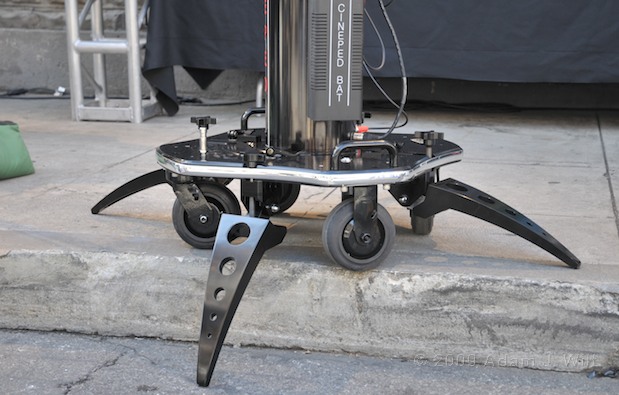
Cineped close up.
The Brothers Quay would approve of the creepy-looking adjustable feet that fulfill the “tripod” (actually quadruped) end of the deal, while the electrically driven center column handles the pedestal part.
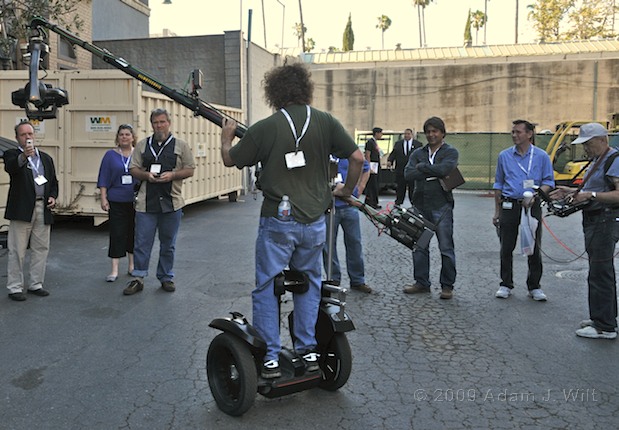
Look! It’s a boom! It’s a Steadicam! It’s a Segway!
This is what you get if you hang a remote head on a boom swuncg from a Steadicam arm affixed to a Segway. Note the chap on the right with the stylish neckwear; he steers the camera by remote control.
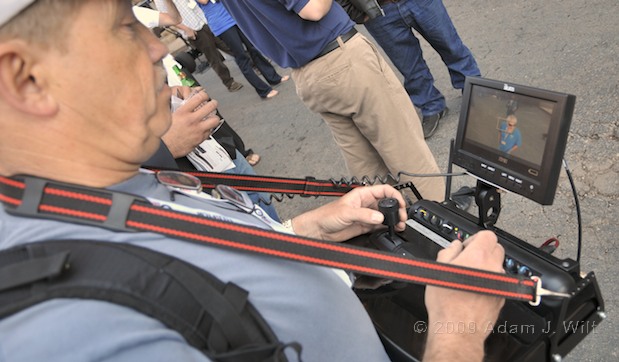
The operator’s console.
He has joysticks for aiming the gyrostabilized camera.
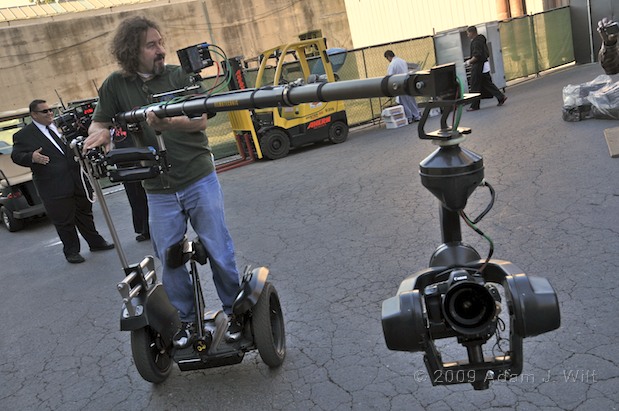
The business end of the rig.
That’s a Canon 5D Mk II in the Filmotechnic FH Mini cradle.
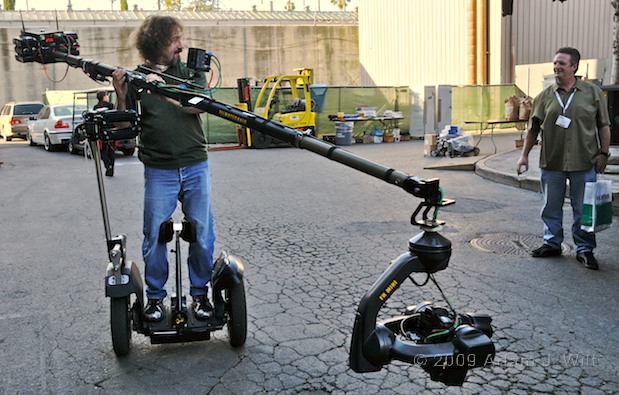
From overhead to ground level, while in motion.
These folks have been shooting high-end car commercials with this rig.
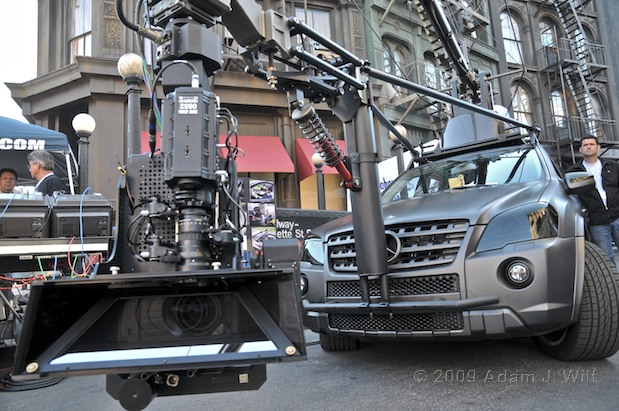
Oh, Lord, won’t you buy me THIS Mercedes Benz…
…”My friends all drive Porsches, but I bought a lens.”
Sorry.
Note the ginormous dual-RED stereo rig, a theme that was repeated again and again during the expo. Nothing really makes me feel nostalgic about the compactness and mobility of the Dalsa Origin like seeing these ungainly contraptions.
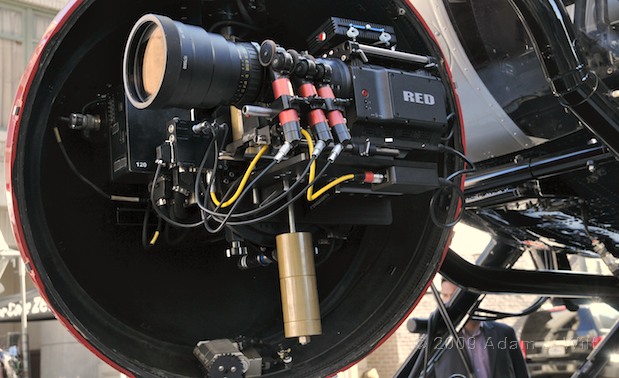
A big red ball containing a big RED.
Camera Copters flies this rig. Observe the RED DRIVE in an Element Technica drive shockmount atop the camera; there is probably no better advertisement for the ET shockmount than this picture. Helis VIBRATE!
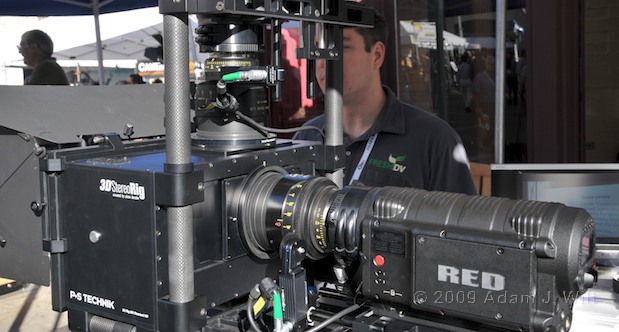
P+S Technik dual-RED stereo rig.
P+S Technic offers this mirror-box RED rig. And is that FreshDV’s Matt Jeppsen lurking behind it?
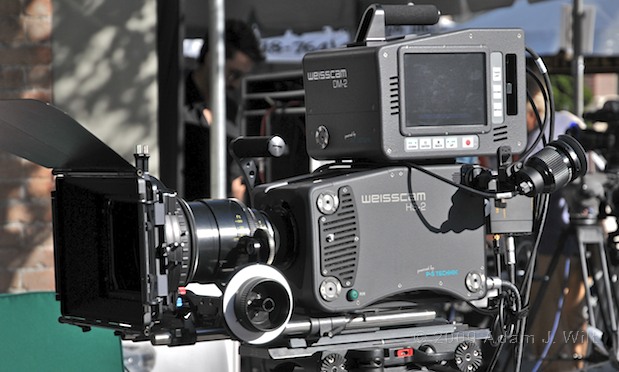
Weisscam HS-2 high-speed digital camera.
P+S Technik also offers the Weisscam HS-2, capable of 1500 fps in 2K, 2000fps in 1080p, and 400 fps in 720p.
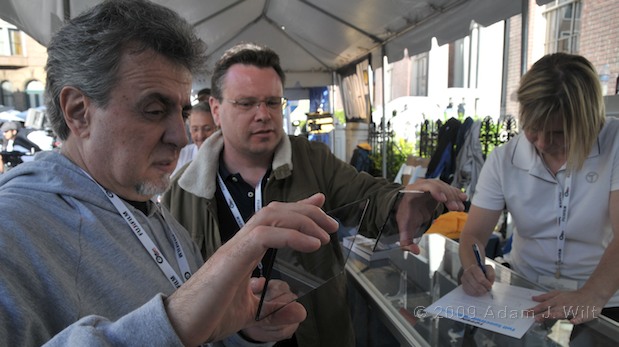
Art Adams and Bob Kertesz eyeball IR filters.
Tiffen has been working on some IR-cut filters suitable for use on Sony extended-gamut cameras like the F23, F35, EX1, and EX3. Art Adams tested an early prototype, but these are newer versions. Both Art and master engineer / Ultimatte guru Bob Kertesz pronounced the new prototypes pleasing to the eye, though formal tests have yet to be done (stay tuned to PVC for those tests, coming soon…)
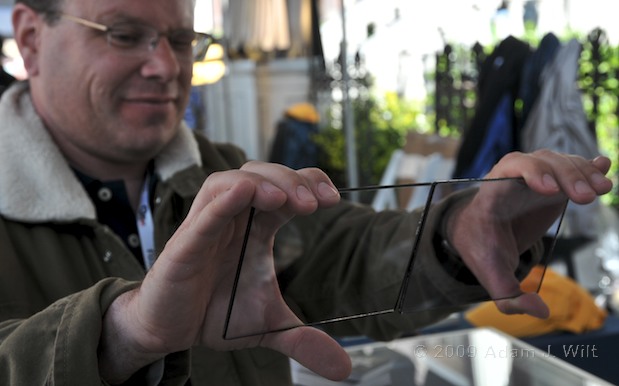
Art compares two versions of the new filter.
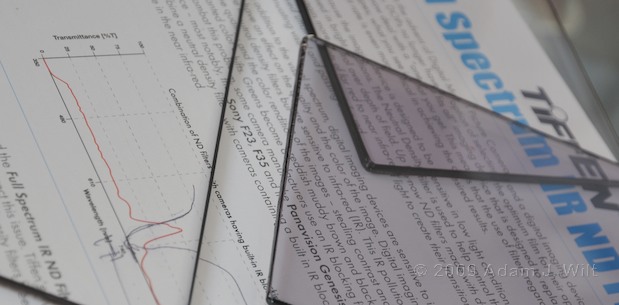
Transmission chart with Art’s doodles.
This new filter supposedly notches out light right around 680 nm. We all noticed a very slight pinkinsh tinge to the filters, but surmised that it may render a color-neutral image on wide-gamut cameras as the overall pink tone may counteract the loss of the 680 nm red light. Again, stay tuned to Art’s channel for test results in the next couple of weeks.
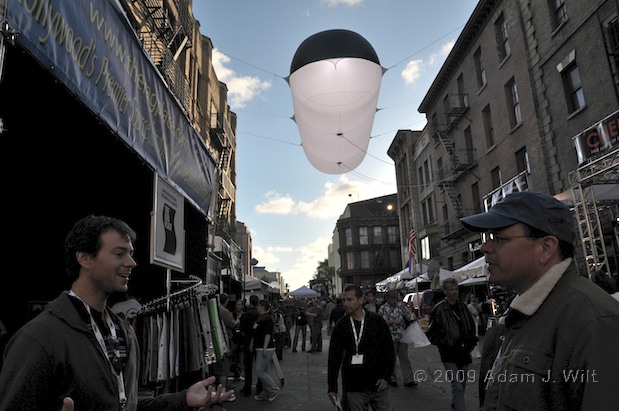
Graham Futerfas and Art Adams chat.
See that big lighting balloon? We’ll come back after dark and see how well it works.
Next: even more film-industry tools, and my favorite LED light from the show…
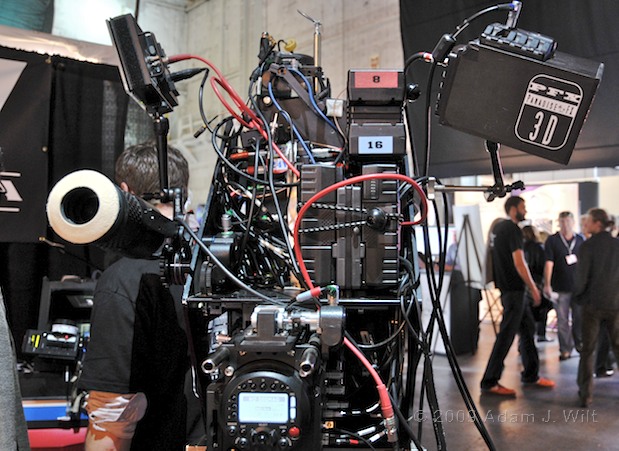
MK-V’s RED stereo rig.
Yes, another 3D rig, this one from Britain’s MK-V. All I can say is that it must be an AC’s full-employment guarantee just building and striking this monster. Handheld, anyone?
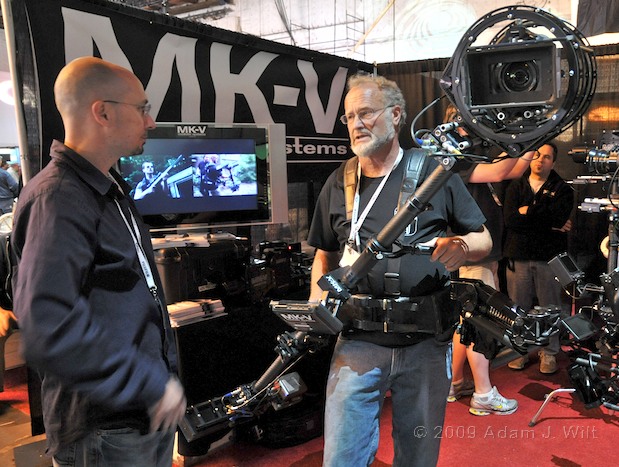
MK-V’s always-upright head on a boom on a Steadicam.
If handheld isn’t your cup ‘o tea, MK-V probably has some sort of modular camera support system that will be.
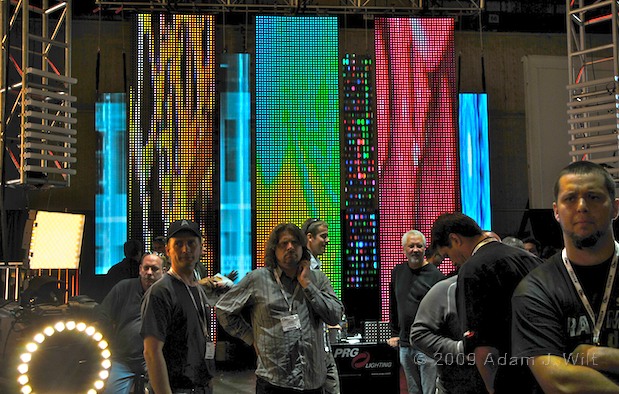
Fun with LEDs.
That’s a Gekko ringlight on the left, a couple of Nila LED bricks on the table, and PRG‘s work in the background. (The fellow on the right isn’t really badly composited into the picture; he just looks that way due to the lighting!)
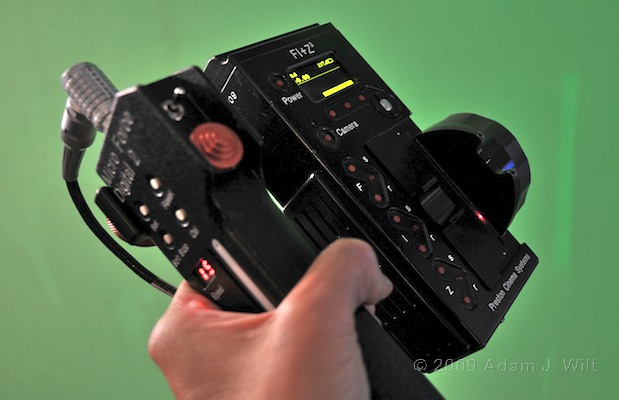
Preston lens controller.
Here’s a close-up of one variant of a three-channel Preston Focus, Iris, & Zoom controller, using a focus & iris box bolted to a Micro Force zoom controller.
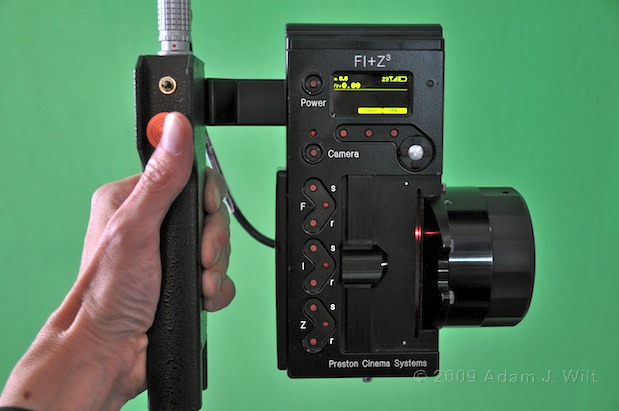
Preston lens controller.
Preston rigs are a bit cheaper than the cmotion systems but, according to BandPro, there’s a 4-5 month wait for a Preston, whereas cmotions are deliverable in less than 30 days.
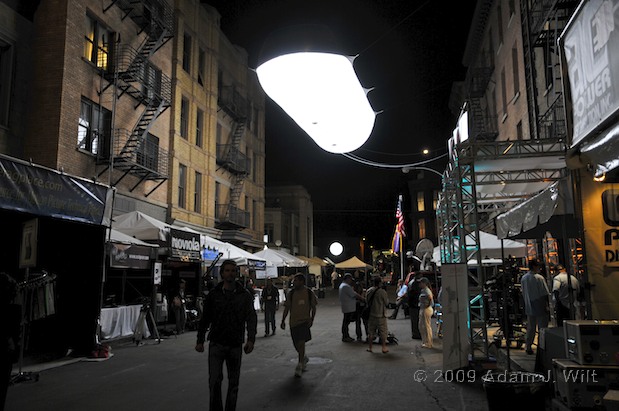
Street scene at night (ISO 200, f/5.6, 1/125 sec).
Here’s that street scene later that night (9:15 pm). Between the lighting balloon and the strategically located instruments atop the buildings, there’s plenty of light to shoot by.
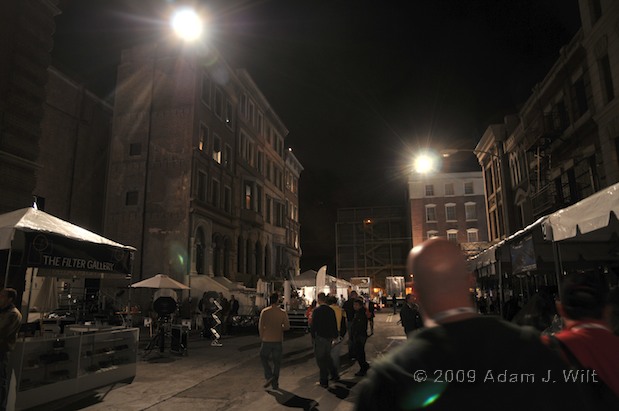
ISO 250, f/3.5, 1/30 sec.
I haven’t fiddled with these pix much in post; I wanted to show what some well-placed lighting can do for overall levels. Here the illumination is provided primarily by the two brutes (?) you see here, plus a similar instrument behind the POV on a similar building.
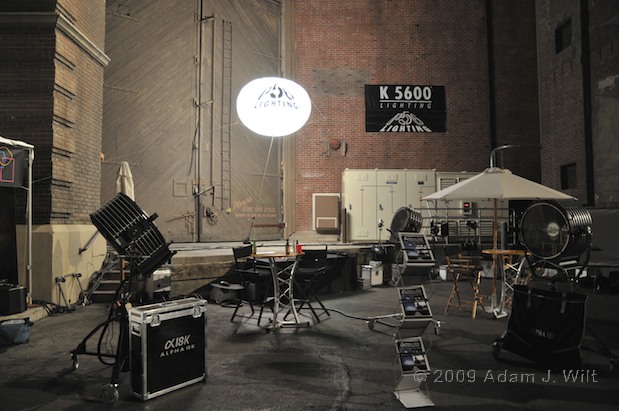
ISO 720, f/3.5, 1/30 sec.
OK, so this one’s a little bit darker, but with a proper T2 prime instead of my f/3.5 zoom, you could still shoot this scene with a RED, an SI-2K, an F35, or the like.
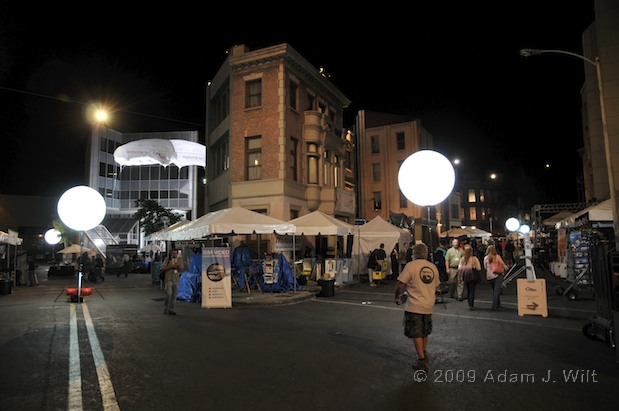
ISO 200, f/4, 1/60 sec
Sorry, no, I don’t know the wattage of those balloons. But it looked a lot darker to the eye that it did to the lens.
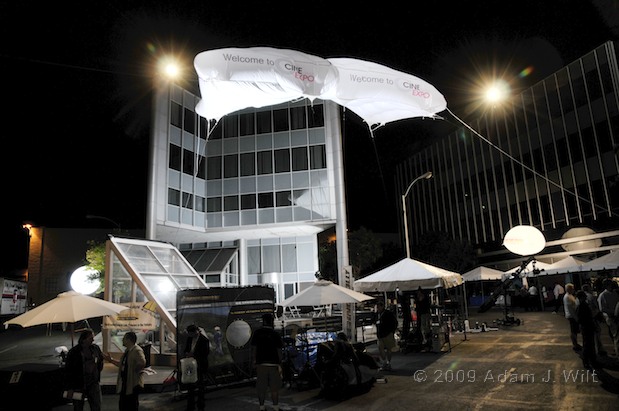
ISO 200, f/4.8, 1/90 sec.
You can use a ground-based instrument to blast light up into this helium-filled reflector and have a nice, soft overhead source.
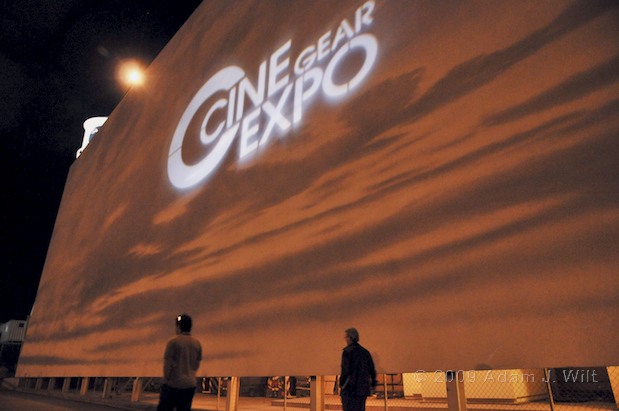
Projection on a backdrop wall.
This huge outdoor wall, painted with a cloudscape (and evilly lit by the streetlights), sits beside a parking lot on Melrose that appears to double as a wave tank for seafaring model work. The parking lot has a sloping entrance ramp and a three-foot high surrounding wall with mooring points. Sadly, it was dry when we were there.
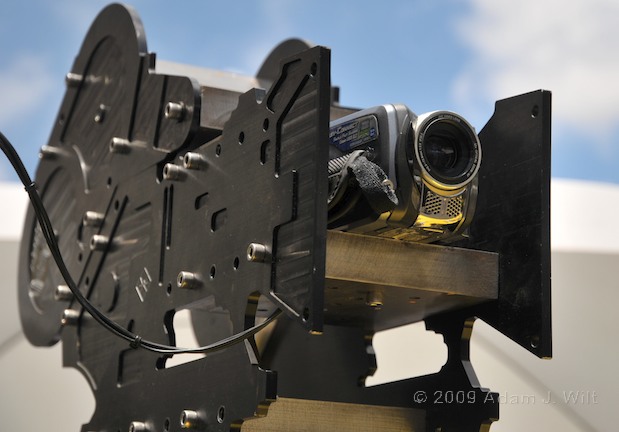
JVC tinycam standing in for a 35mm film camera.
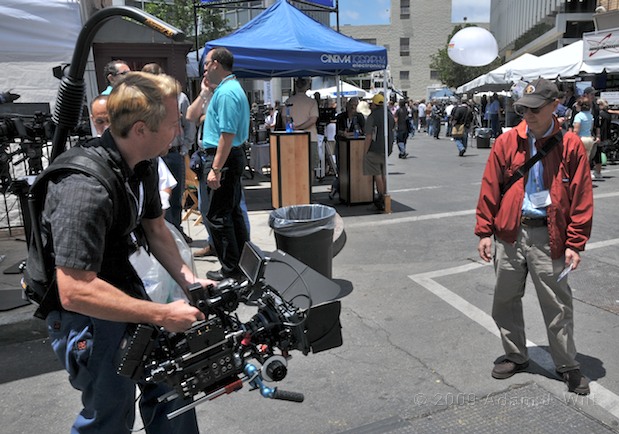
Easyrig 3 flying a RED ONE.
Several folks I spoke to recommended the Easyrig 3 Cinema for making the RED ONE handholdable.
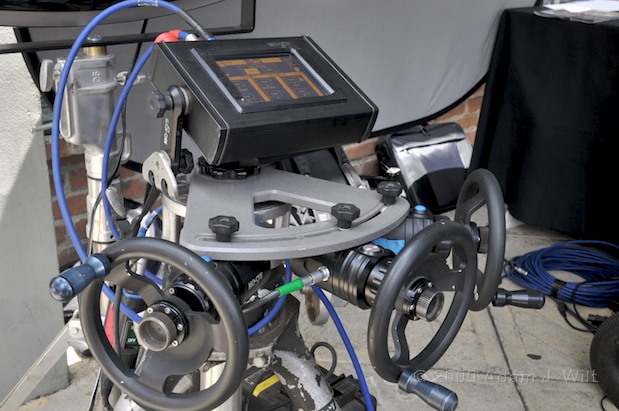
Mo-Sys 3-axis control system.
Scott Billups told me to go see Mo-Sys, a British supplier of motion control systems. This 3-axis rig runs pan, tilt, and roll on a Lambda head…
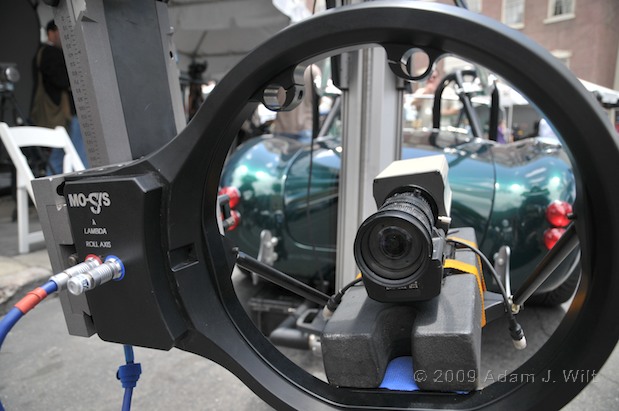
Mo-Sys Lambda head with roll axis on a “British Stick”
…like this one fitted to a “British Stick”, a six-foot-tall motorized leadscrew really called the “Car Pole” and used to fly the camera up and down while the lambda head is aiming it in any gryostabilized direction you choose.
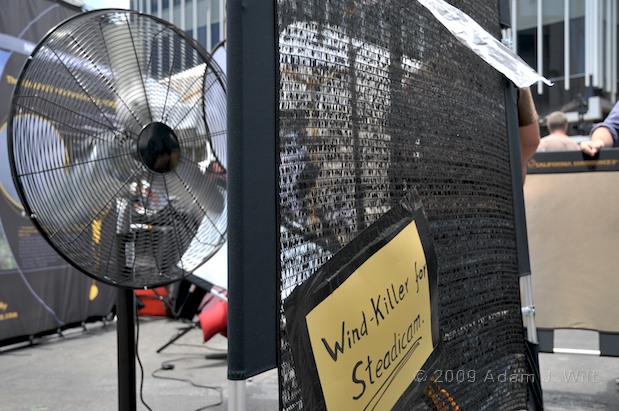
It’s like a pop filter for your Steadicam!
California Sunbounce, makers of large but handholdable reflectors and diffusers, offers this wind killer to keep your Steadicam or other finely balanced rig from being blown off-axis by the breeze. Clever idea, and it really seemed to work, too.
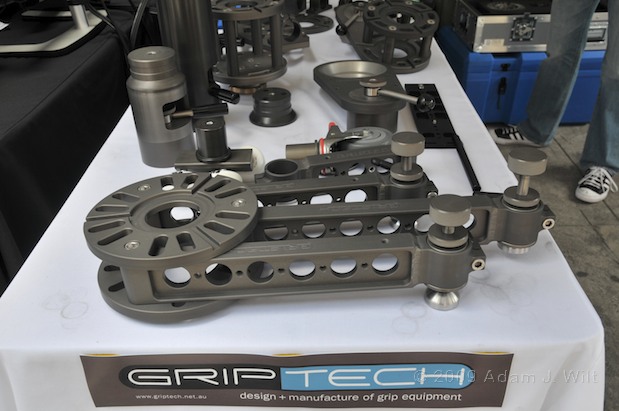
GripTech: it’s Australian for grips kit, mate.
Elegant support gear from GripTech.
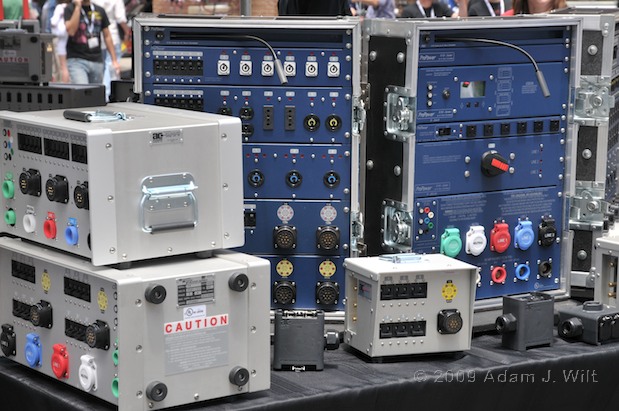
Heavy-duty electrical distribution kit from ProPower and AC Power.
When you get to 3-phase, 400-amp distribution panels like these, with separate line / ground / neutral feeds, I really take what it says on the front panel to heart:
THIS DEVICE TO BE USED BY QUALIFIED PERSONNEL ONLY
FOR USE IN AREAS NOT READILY ACCESSIBLE BY THE GENERAL PUBLIC
I stay as far away as possible and let someone braver and better qualified hook it up.
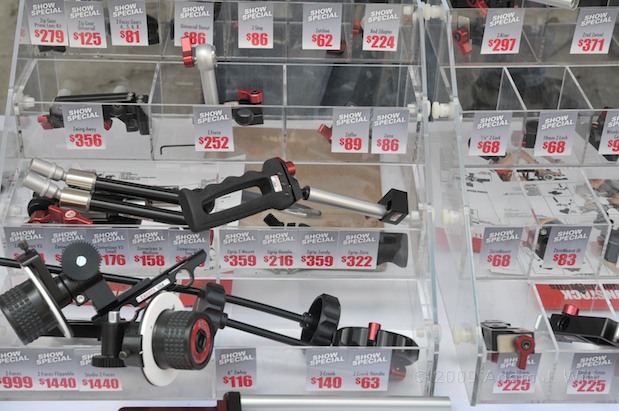
Parts bin at Zacuto’s booth.
If you ever want to assemble a customized Zacuto kit, or just want to see how the parts really fit together, you have to get ’em at a show. They have all the bits ‘n’ bobs lined up in little bins for you to pick and choose from. Zacuto did great business; as of early Saturday afternoon when I took this picture, many of the bins were already emptied out.
The Digital Cinema Society held a seminar on new PL-mount lenses. I’ll leave it up to DCS to document the seminar in full; I just have a couple of interesting images I’ll show.
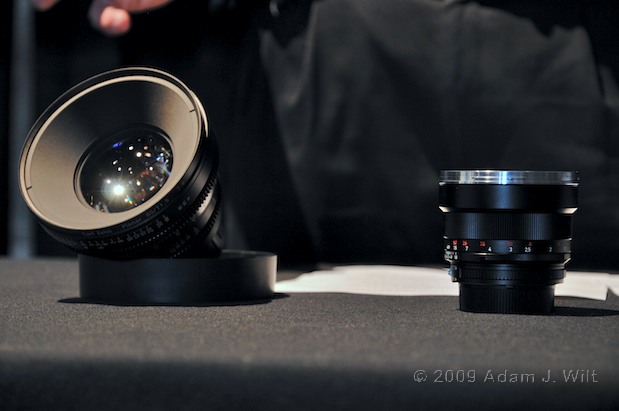
Zeiss Compact Prime, and the CF lens it was derived from.
Richard Schleuning from Carl Zeiss explains how the new Compact Primes are derived from the CF series of still-camera lenses, with all-new cine-quality mounts, gearing, and irises.
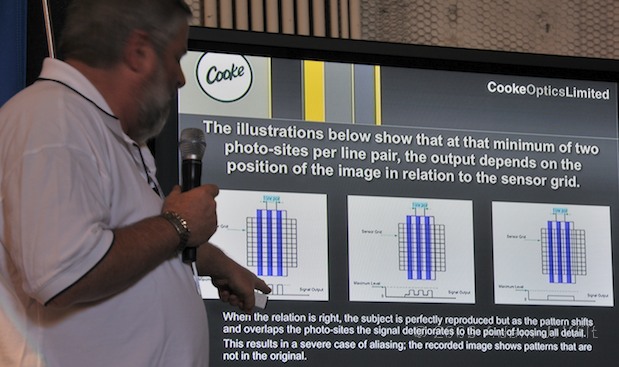
ZGC / Cooke’s Les Zellan explains resolution issues.
Les Zellan from ZGC discussed how most lenses built in the past 30 years exceed the resolving power of a 4K S35-size sensor. He said that the new Panchro series of lower-cost Cooke lenses can be thought of as regular Cookes scaled down to a maximum aperture of T2.8, with corresponding reductions in weight and cost.
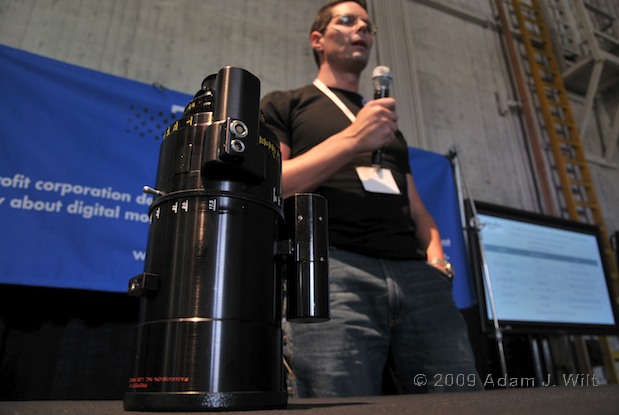
Panavision discusses lenses with built-in encoders.
Panavision‘s Dominick Aiello showed a Panavision zoom for the Genesis with lens encoders built in, to enable metadata capture for post. The encoder for aperture is also a motor; the iris ring is small and close to the flange, making it difficult to get a separate motor wedged in next to it.
Special bonus for getting this far: check out the Zylight IS3, a 220 watt LED fixture using red/green/blue/amber LEDs, settable anywhere from 2500K to 15000K, as well as +/-green.
I don’t have any good pix (Mike Curtis got some; maybe he’ll share).
Fully DMX controllable, as well as wirelessly controllable: any Zylight can be a master or a slave, or any/all can be a slave to a compact little remote, complete with color temperature readout.
Shipping in July, $3500. I want ten of ’em.

Filmtools
Filmmakers go-to destination for pre-production, production & post production equipment!
Shop Now